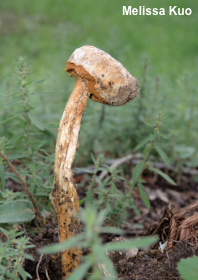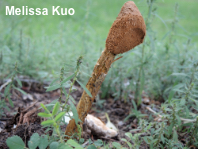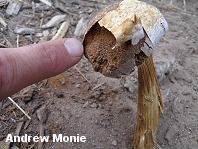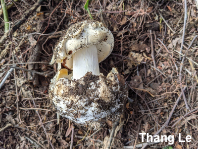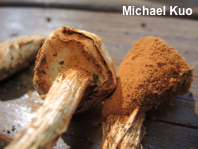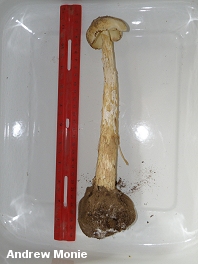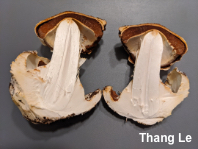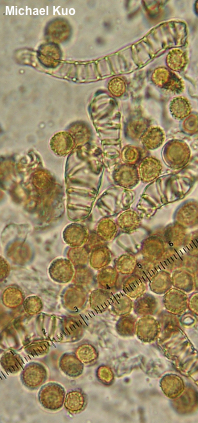| Major Groups > Puffballs > Battarrea phalloides |

|
Battarrea phalloides [ Basidiomycota > Agaricales > Agaricaceae > Battarrea . . . ] by Michael Kuo This funky mushroom looks like a puffball stuck on a long, shaggy spike. It seems to pop up out of nowhere to stand tall for months at a time, covering everything near it with rusty brown spore dust. In North America it is found primarily in desert areas and sagebrush plains, though it also appears in coastal back dunes along the West Coast. Microscopic features are probably not needed to identify Battarrea phalloides, but are well worth your time if you enjoy such things: it features amazing spiral "elators" that look like segmented worms. "Battarraea" is a spelling sometimes applied. Battarrea laciniata is a likely synonym. Battarrea stevenii, once separated on the basis of its gelatinous volva, is a synonym—or, better said, the species names Battarrea stevenii and Battarrea phalloides both represent incoherent entities, phylogenetically (see Martín & Johannesson 2000, Garrido-Benavent 2014), and "Battarrea phalloides" is the older incoherent name. Thanks to Thang Le and Andrew Monie for collecting, documenting, and preserving Battarrea phalloides for study; their collections are deposited in The Herbarium of Michael Kuo. Description: Ecology: Presumably saprobic; growing alone or scattered in dry, sandy soil (coastal back dunes, deserts, sagebrush areas); spring and early summer (but persisting for many months)—or in fall or, in warm climates, over winter; originally described from Great Britain; widely distributed (as a species group) in Europe, Asia, Oceania, Africa, North America, South America, and the Caribbean; in North America primarily found in arid regions and on the West Coast. The illustrated and described collections are from California, Colorado, and New Mexico. Fruiting Body: At first appearing like an underground egg or lump; emerging and developing a long stem with an apical spore case. Spore Case: 2–10 cm across; at maturity convex, with a flattened bottom; the "skin" bald and whitish or grayish, sloughing away on the underside or overall to expose the brown spore mass. Spore Mass: When mature rusty brown and powdery; abundant. Stem: 7–40 cm long and up to 2 cm thick; very tough; becoming hollow; whitish to brownish or brown; ridged or hairy, becoming lacerated-scaly; often rooting for several centimeters into the ground; base enclosed in a whitish, underground volva that often disappears. Flesh: White; unchanging when sliced. Odor: Not distinctive. Spore Print: Brown to rusty brown; more of an explosion than a "print." Microscopic Features: Spores 4.5–8 µm; globose; finely spiny, with blunt spines less than 0.5 µm high. Pseudocapillitial threads hyaline to ochraceous in KOH; 4–6 µm wide. Elators 20–50+ µm long; 5–8 µm wide; yellowish-walled in KOH; cylindrical to fusiform; with thickened spirals; abundant. REFERENCES: (J. J. Dickson, 1785) C. H. Persoon, 1801. (Saccardo, 1888; Rea, 1942; Long, 1943; Cunningham, 1944; Dring, 1964; Phillips, 1981; Smith, Smith & Weber, 1981; Arora, 1986; States, 1990; Schalkwijk-Barendsen, 1991; Lincoff, 1992; Martín & Johannesson, 2000; Esqueda et al., 2002; Hemmes & Desjardin, 2002; Calonge et al., 2004; Calonge et al., 2006; Miller & Miller, 2006; Bougher, 2009; Buczacki et al., 2013; Garrido-Benavent, 2014; Desjardin, Wood & Stevens, 2015; Siegel & Schwarz, 2016; Kibby, 2017; Jeppson, 2018; Læssøe & Petersen, 2019; McKnight et al., 2021.) Herb. Kuo 06151001, 08111502, 01202201. This site contains no information about the edibility or toxicity of mushrooms. |
© MushroomExpert.Com |
|
Cite this page as: Kuo, M. (2022, July). Battarrea phalloides. Retrieved from the MushroomExpert.Com Web site: http://www.mushroomexpert.com/battarrea_phalloides.html |
